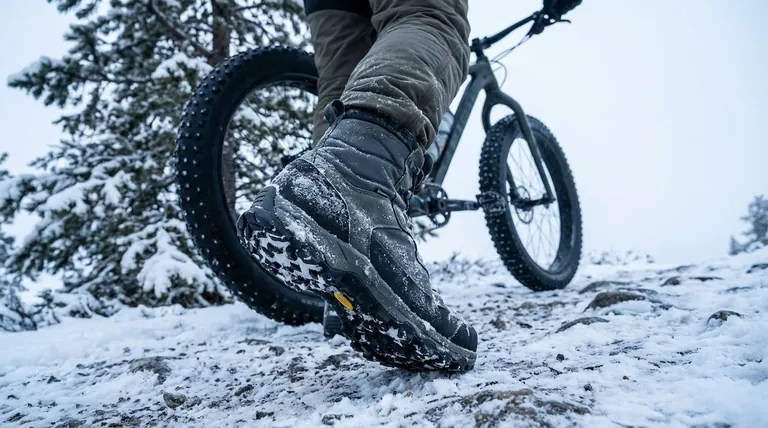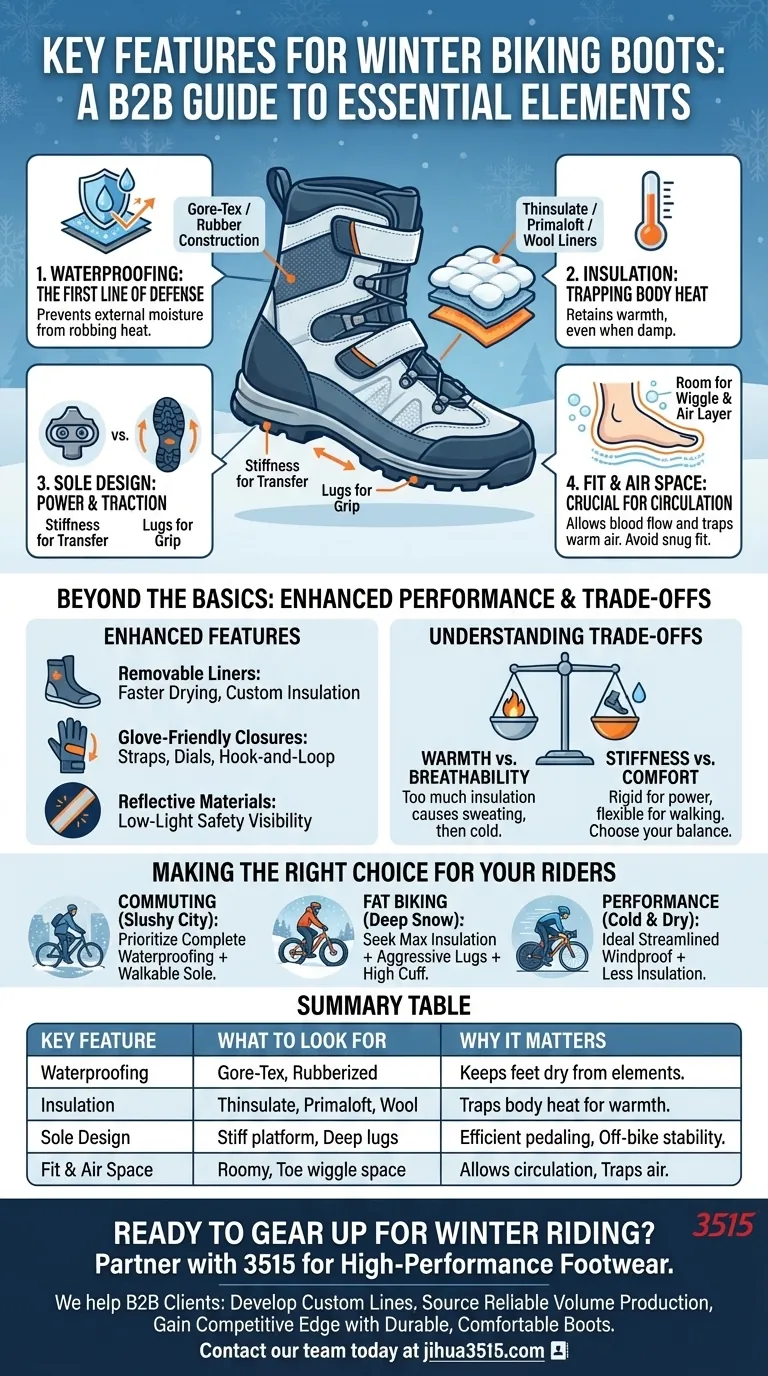Choosing the right winter biking boot is about balancing four critical elements: effective waterproofing against slush and snow, the correct level of insulation for your climate, a sole designed for both pedaling and traction, and a fit that allows for crucial air circulation. These features work together to keep your feet warm, dry, and functional during cold-weather rides.
The best winter biking boot isn't the one with the most features; it's the one that correctly matches its level of insulation and waterproofing to your specific climate and riding style. A mismatch in either direction can lead to discomfort, turning an enjoyable ride into a miserable one.

The Core Pillars of a Winter Biking Boot
Understanding the non-negotiable features is the first step. These four pillars determine a boot's fundamental effectiveness in cold and wet conditions.
Waterproofing: Your First Line of Defense
Your feet must stay dry from the outside in. External moisture from snow, slush, or rain will rob your feet of heat far faster than cold air alone.
Look for boots with proven waterproof materials like a Gore-Tex membrane or a durable rubberized construction. This feature is essential for nearly all winter riding environments.
Insulation: Trapping Your Body Heat
Insulation doesn't create heat; it prevents the heat your body produces from escaping. The amount and type of insulation you need depend entirely on your local temperatures.
Common materials include synthetic fills like Thinsulate or Primaloft, which retain warmth even when damp. Some boots may also use natural wool liners for their excellent thermal properties.
Sole Design: Power and Traction
A winter cycling boot serves a dual purpose. The sole must be stiff enough to transfer power efficiently to the pedals without flexing and wasting energy.
Simultaneously, it needs deep, aggressive lugs to provide confident traction when you have to walk through snow, ice, or mud.
The Critical Role of Fit and Air Space
This is the most misunderstood feature. A winter boot should not be snug. A tight fit restricts blood flow and eliminates the layer of air around your foot, which is a primary insulator.
You need enough room to wiggle your toes freely, even with thick winter socks on. This air space is essential for trapping warmth.
Beyond the Basics: Features for Enhanced Performance
Once the core pillars are met, these additional features can significantly improve comfort, convenience, and safety.
Removable Liners
Boots with removable liners offer two key advantages. They dry out much faster overnight, and they allow you to customize your insulation by swapping in a different liner if needed.
Closure Systems
Consider how you will adjust your boots while wearing gloves. Systems with large straps, hook-and-loop closures, or single-dial adjustments are often much easier to manage in the cold than traditional laces.
Reflective Materials
Winter riding often means lower light conditions. Reflective accents on the heel, sides, or straps are a simple but crucial safety feature that enhances your visibility to others.
Understanding the Trade-offs
No single boot is perfect for all conditions. Being aware of the inherent compromises is key to making an informed decision.
Insulation vs. Breathability
The warmer the boot, the less breathable it is. Choosing a boot with too much insulation for your activity level or climate will cause your feet to sweat. That sweat then gets cold, defeating the purpose of the insulation entirely.
Pedaling Stiffness vs. Walking Comfort
A highly rigid sole is excellent for maximizing power on the bike but can feel awkward and uncomfortable for extended periods of walking. Commuters or fat bikers who hike-a-bike often may prefer a sole with slightly more flex.
Making the Right Choice for Your Ride
Select your boot by matching its features directly to your most common riding scenario.
- If your primary focus is commuting in wet, slushy cities: Prioritize complete waterproofing and a sole that balances pedaling stiffness with walking comfort.
- If your primary focus is fat biking in deep, cold snow: Seek maximum insulation, a high cuff to seal out powder, and the most aggressive sole lugs for traction.
- If your primary focus is performance training in cold, dry weather: A streamlined, windproof boot with less insulation may be ideal to prevent overheating and maintain a connected feel to the pedal.
By matching the boot's design to your specific environment, you invest not just in gear, but in a comfortable and consistent winter riding season.
Summary Table:
| Key Feature | What to Look For | Why It Matters |
|---|---|---|
| Waterproofing | Gore-Tex membrane, rubberized construction | Keeps feet dry from slush, snow, and rain |
| Insulation | Thinsulate, Primaloft, or wool liners | Traps body heat to maintain warmth |
| Sole Design | Stiff for pedaling, deep lugs for traction | Ensures power transfer and off-bike stability |
| Fit & Air Space | Roomy fit for thick socks, toe wiggle room | Allows for air circulation and blood flow |
Ready to Gear Up for Winter Riding?
As a large-scale manufacturer, 3515 produces a comprehensive range of high-performance footwear for distributors, brand owners, and bulk clients. Our production capabilities encompass all types of shoes and boots, including specialized winter biking boots built with the exact features outlined above.
We can help you:
- Develop a custom line of winter cycling boots tailored to your brand and target market.
- Source reliable, high-volume production with consistent quality control.
- Get a competitive edge with durable, functional footwear that keeps riders comfortable all season.
Let's discuss your winter biking boot needs. Contact our team today for a consultation.
Visual Guide

Related Products
- Factory Direct Wholesale Rain Boots Durable Waterproof & Fully Customizable
- Premium Wholesale Waterproof Safety Boots High Performance Protection for Industrial Markets
- High Performance Fire-Retardant Waterproof Safety Boots
- Factory-Direct Wholesale Canvas Boots with High-Traction Rubber Soles
- Customizable Anti-Smash Safety Boots for Wholesale & Private Label Manufacturing
People Also Ask
- What are the characteristics of rubber as a rain boot material? Discover Its Durability & Flexibility
- What variety of rubber boots is available? From Rain to Safety and Medical Solutions
- What are the main materials used in the production of rain boots? A Guide to Durability & Comfort
- What are the key characteristics of rain boots? Essential Features for Total Dryness
- What are the liner materials for rain boots? Cotton vs. Blends for Comfort & Durability



















